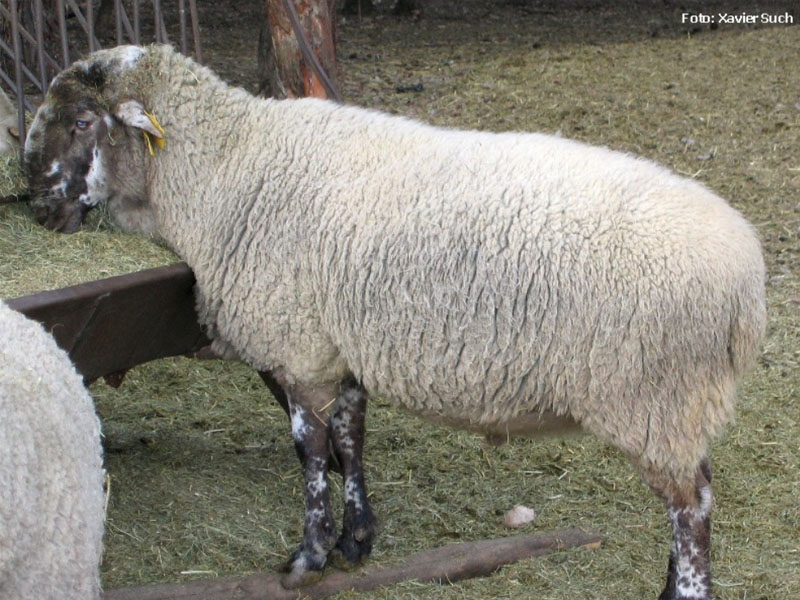Ripollesa Wool
Variety: Ripollesa wool
Origin of the fibre: Ripollesa sheep.
Provenance: Ripollès, Catalonia, Spain
Characteristics:
- Soft and resistant fibre.
- Colour white or creamy white.
- Used for the production of high-quality fabrics such as blankets, rugs, warm clothing, etc.
- Environmentally friendly production.
Ripollesa wool is a variety of wool native to the Ripollès region, located in the province of Girona, in Catalonia, Spain. This wool is characterised by being very soft to the touch and with a fine, curly fibre, which makes it ideal for making garments.
In addition, its colour is naturally creamy-white, although it can also be found in natural colours such as grey and brown.
HISTORY OF RIPOLLESA WOOL
Ripollese sheep are the most abundant sheep species in Catalonia. In fact, this breed is considered, together with the 'xiqueta' and the 'aranesa', to be one of the three indigenous sheep breeds of the Autonomous Community of Catalonia.
These sheep are named after the Ripollés region of Girona, which is home to one of their main herds. However, it is also known by other names (such as queralpina, pirenaica, berguedana or solsones), all of which refer to the districts where it is farmed.
Although it is particularly abundant in the northwest of Catalonia (especially in Barcelona and Girona), it is possible to find specimens throughout the Autonomous Community. It can also be found in Teruel (Aragon).
WHAT ARE ITS ORIGINS?
The origin of this breed dates back to ancient times. It is considered to be the result of crossbreeding between the Tarragona sheep that originally populated the Central Pyrenees with Merino breeds brought there by shepherds.
It is important to bear in mind that, almost from the beginning, this species was crossed with many other breeds, both national (e.g. Segureña) and foreign (e.g. Romanov). This increased its morphological diversity and compromised its purity.
The exploitation system traditionally linked to this breed was transtermination. However, the current model is semi-extensive. This involves grouping herds with half a thousand breeding females.
The Asociación Nacional de Criadores de Ovino de Raza Ripollesa (ANCRI) is an organisation set up in 1987 to characterise and control the production of this species. Today, it has around twenty registered farms.
CHARACTERISTICS OF WOOL
It should be noted that Ripollesa wool is highly valued in the textile industry due to the high quality provided by its distinctive characteristics:
- The type of fleece is inter-fine, with a diameter of 25 microns.
- The weight of the fleece varies between 2 and 4 kg, with no significant differences between males and females.
- The wool covers practically the entire body of the sheep, with the exception of the head, belly and limbs.
- It is creamy-white in colour and is considered rustic due to its great durability.
- It is very soft to the touch.
- High resistance to water, abrasion and wear.
- Great thermal insulation power.
- When lambs are born, it is possible to distinguish two types of wool: curly (rascles) or smooth (peluts). The latter has more abundant hair.
USES OF RIPOLLESA WOOL
Its applications in the textile world are very wide.
Blankets
This type of wool is particularly appreciated for making blankets due to its excellent thermal properties and optimum breathability. This, together with its all-terrain character, only confirms its suitability for this purpose.
Clothing and accessories
One of the main uses of Ripollesian wool.
Sustainable, warm, soft, smooth, resistant? This type of wool offers optimum conditions for making all kinds of garments and accessories.
Craftsmanship
Ripollesa wool has had some of its most imaginative applications in handicrafts. It is possible to find everything from DIY handicrafts (such as textile jewellery or toys) to household items (such as flowerpots or rugs).
Mattresses
Did you know that this wool was once used as a filling for mattresses? Its ecological and healthy properties (it is antibacterial, breathable and hypoallergenic) guarantee an extremely comfortable sleep.
Conclusion
In addition to being a select raw material, Ripollesian wool has seen its usefulness multiply thanks to the boundless inventiveness of local producers.



Users Reviews